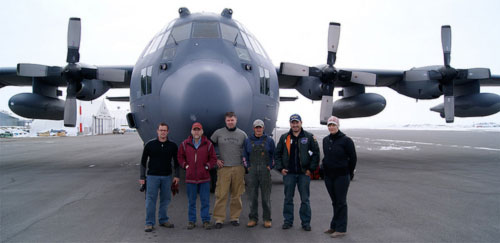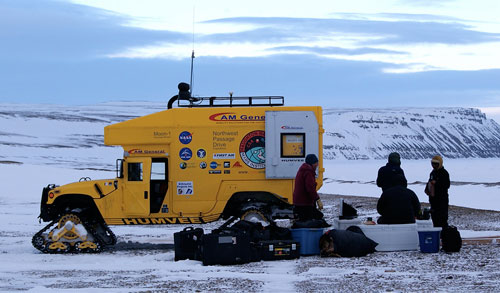This blog is courtesy of Haughton Mars Project (HMP)
For more information please visit www.marsonearth.org
Two twin otter flights came in today with 10 participants total, including the K10 robot team lead by Dr. Matt Deans, supported by Dr Trey Smith, Dr Hans Utz, Susan Lee, Vinh To and Eric Park (all from NASA Ames), and Byron Adams and Kelsey Young (both from the Geology Dept. at Arizona State University). On the second flight was Peter Ikaluk from Resolute Bay and [yours truly] Elaine Walker (E/PO, Mars Institute).
The K10 robot team will be following up on work done during the 2009 field season by Dr Pascal Lee (Director, HMP / NASA Ames, Mars Institute, SETI Institute), Dr Mark Helper (Distinguished Senior Lecturer, University of Texas at Austin) and Dr Essam Heggy (Planetary Scientist, JPL). Last season they completed simulated lunar geological and geophysical traverses as part of their studies of robotic follow-up to human exploration, and of the efficiencies of pressured rover and EVA exploration.
Peter and Elaine’s flight landed at HumVee Beach where the Moon-1 Humvee Rover and supporting vehicles are parked. Elaine took pictures and video of the site while Peter and the two Ken Borek pilots loaded all four of the Humvee tracks onto the twin otter. They are quite heavy.
John Schutt (HMP camp manager) gave the new arrivals a tour of the HMP base camp and safety briefings, then lead the evening meeting in the mess tent. Jeff Fagen is our new camp cook. Jeff is from Vanouver, and so far he is a big hit. His food is excellent as well. He and John Schutt have additional support from Nathan Kalluk, Star Amurulak and Peter Ikaluk from Resolute Bay, and Terry Pijimini and Ben Audlaluk from Grise Fiord.
There are several research projects going on simultaneously including the ongoing Arthur Clarke Mars Greenhouse effort lead by Matt Bamsey (CSA), a space biology study led by Dr’s Robert Ferl and Anna-Lisa Paul (Univ. of Florida), the K10 robot team led by Dr Matt Deans, research on the immune system by Dr Valerie Myers from NASA JSC, as well as geology research by Dr. Pascal Lee and Kelsey Young, as part of her PhD thesis at ASU. Pascal and Kelsey hope to gain further understanding in the glacial evolution and geologic history of the Haughton impact structure, date the crater more accurately, and to learn more about the makeup and size of the impactor itself, using the geochemical trace that it left behind.
It was 6 celsius today with light rain. The mood is very high at camp and we look forward to a great season as we near the peak in camp population.
Please stay tuned for photos.


